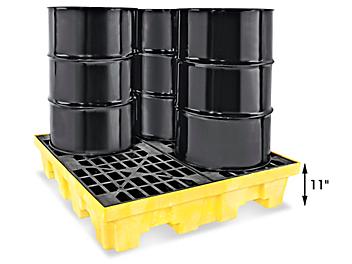
In industries dealing with oil, chemicals, and other hazardous substances, spill management is paramount. Accidental spills can lead to environmental contamination, regulatory fines, and pose significant risks to human health and safety. One essential component of spill management is the use of IBC (Intermediate Bulk Container) spill pallets. In this article, we’ll delve into the significance of IBC spill pallet and their role in mitigating risks associated with hazardous substance spills.
Introduction to IBC Spill Pallets
IBC spill pallets are specially designed containment units that provide a secure and stable platform for storing and handling Intermediate Bulk Containers. These pallets are engineered to withstand the weight of IBCs, which typically hold large volumes of hazardous liquids. The primary purpose of an IBC spill pallet is to prevent leaks, drips, and spills from reaching the surrounding environment in case of container failure or accidental spills.
Features and Construction of IBC Spill Pallets
Modern IBC spill pallets are constructed from durable materials such as polyethylene or steel, ensuring longevity and resistance to corrosion. They are typically equipped with features such as:
- Containment sumps: These are integral parts of the pallet design, capable of holding the entire contents of the IBC in case of a spill or leak.
- Grating: Many IBC spill pallets come with removable grating, allowing easy access for inspection and cleaning.
- Forklift pockets: Built-in pockets facilitate easy transportation and relocation of the pallets using forklifts or pallet jacks.
- Compliance: High-quality IBC spill pallets comply with relevant regulations and standards, ensuring they meet the requirements for safe storage and containment of hazardous substances.
Importance in Hazardous Substance Management
- Environmental Protection: IBC spill pallets play a crucial role in preventing hazardous substances from contaminating soil, groundwater, or surface water in the event of a spill. By containing the spill within the pallet’s sump, the risk of environmental damage is significantly reduced.
- Safety: Ensuring the safety of personnel is paramount in industries dealing with hazardous substances. IBC spill pallets help minimize the risk of accidents by containing spills and preventing slippery surfaces that could lead to slips, trips, or falls.
- Regulatory Compliance: Many regulatory bodies mandate the use of containment systems such as IBC spill pallets to mitigate the risks associated with handling hazardous substances. Compliance with these regulations is essential to avoid fines, penalties, and legal liabilities.
- Cost Savings: While investing in IBC spill pallets incurs an initial cost, the potential savings in terms of cleanup costs, regulatory fines, and reputational damage far outweigh the investment. By preventing spills from spreading and causing extensive damage, IBC spill pallets contribute to cost-effective risk management.
Conclusion
In conclusion, IBC spill pallets are indispensable tools in the management of hazardous substances. Their robust construction, compliance with regulations, and role in environmental protection and safety make them essential assets for industries where spills pose significant risks. By investing in quality IBC spill pallets and integrating them into spill response plans, businesses can effectively mitigate the potential consequences of spills and safeguard both the environment and human health.
